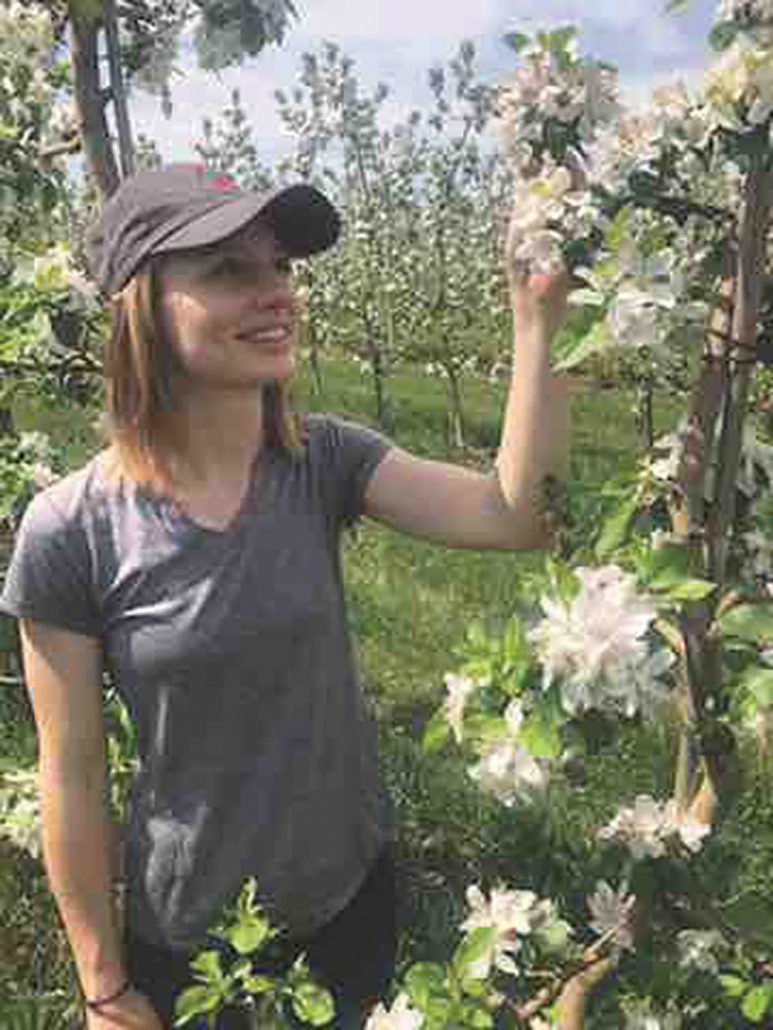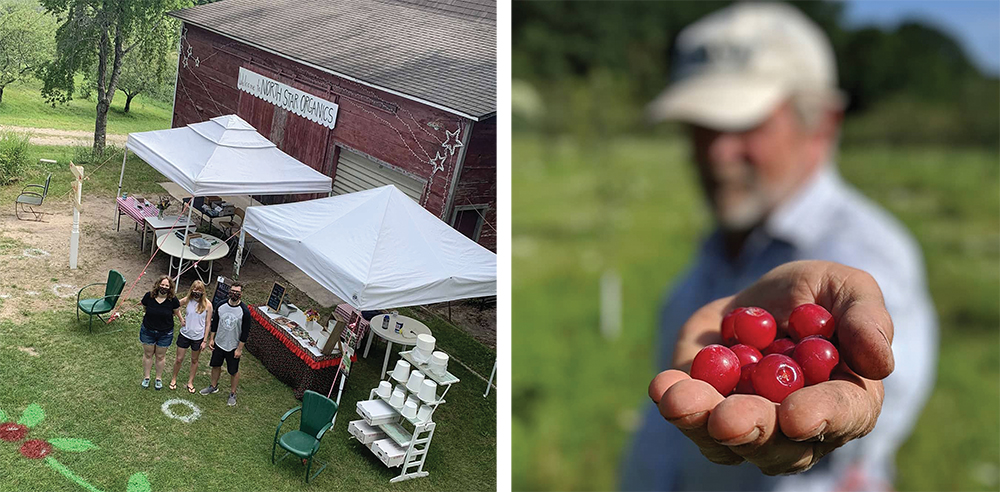Heat waves, frost, drought, and torrential rain vs. our cherry orchards
By Madeleine Hill Vedel
Current Contributor
Temps at 90 degrees on April 1. Frost in May. Drought in June. Torrential rain storms of up to 4.75 inches within five hours in July.
It has not been a typical year for Northern Michigan cherry growers. But then, typical years are either a thing of the past or the rarest of occurrence.
There is a reason our region is—and has been—carpeted in cherry orchards, apples, and now grapes. We have the daylight of being close to the 45th parallel, but also the modifying lake effect, which used to bring protective snow cover in the winter, limit frost events in the spring, keep summer temperatures mild, and extend ripening days into the fall months.
“There’s nobody who follows the weather as much as a farmer,” says Cheryl Kobernik of North Star Organics Farm in Frankfort. “For cherry growers, when it is 70-75°F or 80°F degrees in March, you begin to cringe. It can’t do that without having an effect on the fruit in April/May/June. It will get cold again, and it will freeze.”
In speaking with a number of local cherry farmers, the consensus is that more than a few are wondering how much longer this region will be viable for cherry farming. Where once the peninsula was identified as ideal cherry-growing land, the years and seasons have become more variable; years with poor crops and even crop failures have become more frequent.
“We used to rely on Lake Michigan to moderate our temperatures—we had that whole moderating effect of the lake. That has really changed,” says Nikki Rothwell, Northwest Horticulture Research Center consultant. “Those really weird days of heat in April. Hail is an issue. Unpredictable rainfalls that cause splits and rot. A lot of people are putting in irrigation where we never needed it before.”
For the Koberniks, it was a year of near-total crop failure, making it two years in a row.
“One more year like this, and we’ll be dipping into our retirement,” Kobernik says. “We can’t do that.”
Price and Conditions
For Gene Garthe of Garthe Farms in Northport, he brought in half the crop of what he did last year—and last year, he harvested only 60 percent of what his trees can carry.

“Normally, we figure July as one of the driest months of the year—wrong this year,” Garthe says. “Drought in June, and torrential rains in July. If you’re a sweet cherry grower, it’s a disaster. Just as the fruit starts to ripen, it cracks and rots from the rain. What is that caused by? The climate is certainly changing from the normal, but what’s the new normal? There is none. Every year is different. This makes it a huge challenge for someone growing something that depends on certain conditions.”
On the bright side, the price per pound for cherries has finally hit 50 cents, a price point that has not been seen since the 1970s. For many, this was the Holy Grail, the price point at which cherry farming becomes profitable. For those who did have a crop, even a small one, the year has been good to them.
When I spoke with Kobernik about price last year, she elaborated on how it works:
“The highest price may be 50 cents a pound [for 100 percent perfect cherries], but most will be in the 30- to 40-cents range, because of the grade. Your fruit could have wind damage, or too many stems, or too big, too small, under color—12 different items… if you go down below 80 percent, they won’t even take them.”
Diversification and Anomalies
With a Master’s degree in entomology from Michigan State University, Heather Leach, the new orchard manager at Cherry Bay Orchards in Suttons Bay, shared how that farm has diversified geographically:
“The pockets closer to the lake pulled through for us. Still, some we had to walk away from. They didn’t set enough fruit. Some produced well, due to their location and position in the extreme weather events… From Bingham to north of Northport—different geography, proximity to the lakes, all helps regulate. Different geographic regions are an extra insurance policy for us.”
It is impossible to avoid the topic at hand: climate change.
Whether it is milder winters which permit invasive pests such as the Spotted Wing Drosophila fruit flies (Drosophila suzukii) to survive and spread, warm spring days which push the trees to precociously bud and bloom, unusually timed droughts and rain events—the only weather event that appears consistent is the potential killing frost or freezing wind at some point before June 1.
“The anomalies just keep increasing, every year. It’s not cumulative,” Kobernik says. “Thirty-six individual years we’ve had this orchard. But these are real anomalies. Climate change is definitely affecting us. There’s a reason that cherries are in this part of the state, and it’s not working for us anymore. It’s unpredictable. The winters are too warm. We only plowed five times this year. It hasn’t hit below zero in years. Before, it always did.”
Walking through the Garthe Orchards this spring, hunting morels between the rows of trees, Garthe paused to pluck a cherry bud, open it up, and reveal the brown (dead) fruit inside. Somewhere between hopeful and fatalistic, he knew already that the season’s harvest would be affected, as it proved to be.
With the cherry harvest finished, it is now a time for reflection, for wondering what is truly happening in our orchards: what is a seasonal variation? What might be attributed to the effects of more carbon dioxide in the atmosphere? What is the effect of increased carbon levels on the trees? Why such sporadic production across all crops this year?
“I don’t think it can be completely attributed to the cold temps we had this spring.” Garthe explains. “Climate change is causing a variation in the weather, up and down. The cold, atypical spring temperatures caused havoc in the bloom and pollination [stages, early on]. What we’re seeing in the orchard is counter-intuitive. We’re seeing more crop in the valley than up in the ridges—caused by cold winds? It’s not what we normally associated with a decreased crop. Typically, cold air sits in the valley and kills the blossoms. It’s another aspect of this year.”
Wetter Than Ever
Locals took note of this wetter-than-ever July.
Wedding celebrations postponed from last year’s pandemic summer have tested the rain-readiness of our many event venues, the water-resistance of the rental tents. At times, it felt like weekly torrential downpours.
If climate scientists cannot and will not predict specific weather patterns in our future, they do confirm that storms will be fiercer; weather events more varied and unusual.
Leach—having lived the past few years in Pennsylvania, where she worked at Pennsylvania State University—likened the weather this past summer to what she experienced back east. The Atlantic coastline knows hurricane conditions and their fall-out: days of heavy, tactile, humid heat crackling with electricity and powerful storms washing out roads, flooding basements.
On the bright side?
“It was a great year for growing wood,” Kobernik says.

Garthe, Rothwell, and Leach confirm. The foliage is healthy and full. The trees look great; there’s good green tissue on them that can only help in the future. And it is possible that the drought weather in June kept this year’s Spotted Wing Drosophila population down.
“We have horticultural practices to mitigate this risk, but the options are fewer and fewer as we are faced with these challenges,” Leach says. “It is interesting, and not what I expected moving back. I noticed changes [after six years], it felt like the seasons were flipped: summer early and spring late. The trees aren’t meant to go in that order. With all that considered, we had a good year, but looking ahead to the future, and particularly for this industry, we’re having the heart-breaking conversation: Are we still a cherry growing region? In answer: Yes, we do still feel confident. It’s still an excellent region to grow cherries, but we need to implement additional agricultural practices—diversifying our crops, planting more apples, If not cherries then these—to break even. We need to look at the industry as a whole: not to take cherries out of it, but to protect ourselves.”
Bad years happen.
Garthe has lived through 2002, a year of wind freeze; 2012, a year of early spring heat and mid-May frost; and now 2021. Serious crop failures occurring, on average, once per decade. The carrying capacity for tart cherries in our region is about 150 million pounds. This year’s harvest was closer to 42 million.
However, there have been good years in recent memory—2019, in particular, was a banner year.
This is the life of a farmer. Nothing is assured.
And yet, you plant a crop where the conditions are promising. You do everything possible to give your plants, your trees, a chance to produce abundant and healthy fruit.
Rothwell and her colleagues at the Research Station are looking to put on a Fruit School this winter to cover some of the issues that have been mentioned in this article, looking at return bloom on the apples and cherries, and to explore the unknown on climate variability and how it is affecting—and will affect—fruit, in the long run.
In the meantime, she advises diversification, both in crops and geographically. Those who are able to are doing so.
A version of this article first published in the Glen Arbor Sun, a Leelanau County-based semi-sister publication to The Betsie Current. Madeline Hill Vedel wrote an article, “Rain with a Side of Pandemic: Cherry farmers find creative solutions during challenging season,” which published on September 10, 2020, in our Volume IX, Issue 13; find it in our online archives. For more information about North Star Organics and the Kobernik family, visit NorthStarOrganics.com or visit “North Star Organics” on Facebook; call 231-386-7905 for Garthe Farms; call 800-836-3972 for Cherry Bay Orchards.
Featured Photo Caption: The aerial view of North Star Organic cherry farm’s U-pick stand during 2020. In 2021, they did not have enough cherries to warrant a U-pick. Images courtesy of North Star Organics.




